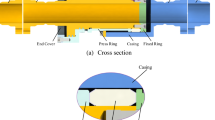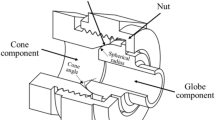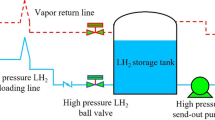Abstract
In this paper, a finite element method is proposed to predict the contact pressure of the metal seal in the subsea pipeline connector with regard of the penetration load on the critical sealing surface. Further, a fast GA-ANN model is proposed on the basis of GA-ANN to optimize the sealing structure of the connector, which uses only 3–6 % of the calculation time compared to the traditional GA-ANN model. The fast GA-ANN is further coupled with NSGA-II in the multiple objective optimization of the sealing structure and the results are compared with that of the response surface methodology (RSM). In terms of the number of valid candidate points and the optimal candidate point, NSGA-II coupled fast GA-ANN model performs much better than RSM. The hydrostatic pressure tests were carried out with the optimal sealing structure by the fast GA-ANN and the results meet the design requirements very well.
Similar content being viewed by others
References
H. Wang et al., Modeling of multi-scale transport phenomena in shale gas production - a critical review, Applied Energy, 262 (2020) 114575.
B. Lin and Y. Kuang, Natural gas subsidies in the industrial sector in China: national and regional perspectives, Applied Energy, 260 (2020) 114329.
A. A. Olajire, Flow assurance issues in deep-water gas well testing and mitigation strategies with respect to gas hydrates deposition in flowlines - a review, Journal of Molecular Liquids, 318 (2020) 114203.
Y. Yue, Z. Liu and X. Zuo, Integral layout optimization of subsea production control system considering three-dimensional space constraint, Processes, 9 (11) (2021) 1947.
Y. Wang et al., Dynamic Bayesian networks for reliability evaluation of subsea wellhead connector during service life based on monte carlo method, Journal of Loss Prevention in the Process Industries, 71 (2021) 104487.
F. Yun et al., Analysis of sealing and leakage performance of the subsea collet connector with lens-type sealing structure, Journal of Marine Science and Engineering, 8 (6) (2020) 444.
H. Zhao et al., Metal sealing performance of subsea X-tree wellhead connector sealer, Chinese Journal of Mechanical Engineering, 28 (3) (2015) 649–656.
Y. Li et al., Research on bearing capacity and sealing contact characteristics of the subsea wellhead connector, Proceedings of the Institution of Mechanical Engineers Part M-Journal of Engineering for the Maritime Environment, 237 (1) (2022) 153–165.
W. Zeng et al., Sealing reliability assessment of deep-water oil and nature gas pipeline connector considering thermomechanical coupling, Proceedings of the Institution of Mechanical Engineers Part M-Journal of Engineering for the Maritime Environment, 236 (1) (2022) 196–208.
Z. Wei et al., Static metal sealing mechanism of a subsea pipeline mechanical connector, Advances in Mechanical Engineering, 8 (7) (2016).
K. Zhang et al., Theoretical investigation of the compression limits of sealing structures in complex load transferring between subsea connector components, Journal of Natural Gas Science and Engineering, 44 (2017) 202–213.
Y. Li et al., Metal sealing mechanism and experimental study of the subsea wellhead connector, Journal of the Brazilian Society of Mechanical Sciences and Engineering, 42 (1) (2020) 26.
M. Duan et al., Theoretical investigation on hub structure design of subsea connectors, Thin-Walled Structures, 159 (2021) 107036.
Y. Wang et al., A dynamic failure analysis methodology for fault diagnosis of fatigue cracks of subsea wellhead connectors with material aging, Process Safety and Environmental Protection, 159 (2022) 35–52.
F. Yun et al., Thermal-structural coupling analysis of subsea connector sealing contact, Applied Sciences-Basel, 12 (6) (2022) 3194.
D. Liu et al., Structural analysis and experimental study on the spherical seal of a subsea connector based on a non-standard O-ring seal, Journal of Marine Science and Engineering, 10 (3) (2022) 404.
K. Zhang, J. Liu and M. Duan, Analytical calculation method for predicting compression deformations and sealing performance of subsea connector under operating condition, International Journal of Pressure Vessels and Piping, 202 (2023).
S. K. S. Kambhammettu, L. R. Chebolu and A. P. Deshpande, A wedge penetration model to estimate leak through elastomer-metal interface, International Journal of Advances in Engineering Sciences and Applied Mathematics, 12 (1–2) (2020) 65–72.
X. M. Huang et al., Fractal analysis of the penetration flow through micro-nano porous gaskets with effects of slippage and stress sensitivity, Fractals-Complex Geometry Patterns and Scaling in Nature and Society, 27 (3) (2019).
M. S. H. Kalathingal, S. Basak and J. Mitra, Artificial neural network modeling and genetic algorithm optimization of process parameters in fluidized bed drying of green tea leaves, Journal of Food Process Engineering, 43 (1) (2020).
M. Vakili et al., A hybrid artificial neural network-genetic algorithm modeling approach for viscosity estimation of graphene nanoplatelets nanofluid using experimental data, International Communications in Heat and Mass Transfer, 82 (2017) 40–48.
A. Jarndal, S. Husain and M. Hashmi, Genetic algorithm initialized artificial neural network based temperature dependent small-signal modeling technique for GaN high electron mobility transistors, International Journal of Rf and Microwave Computer-Aided Engineering, 31 (3) (2021) e22542.
X. Xiong et al., Intelligent prediction model of the triaxial compressive strength of rock subjected to freeze-thaw cycles cased on a genetic algorithm and artificial neural network, Geofluids, 2021 (2021) 1250083.
F. Yu and X. Xu, A short-term load forecasting model of natural gas based on optimized genetic algorithm and improved BP neural network, Applied Energy, 134 (2014) 102–113.
Y. W. Zhang et al., Multi-objective optimization and experiment of nylon cord rubber in expandable packer, Petroleum Science, 18 (1) (2021) 269–284.
F. Zhang, H. C. Shui and Y. Zhang, Parameter optimization of sealing performance for packer rubber, Industrial Lubrication and Tribology, 71 (5) (2019) 664–671.
K. Jiao et al., Optimization and experimental study of the subsea retractable connector rubber packer based on mooney-rivlin constitutive model, Journal of Marine Science and Engineering, 9 (12) (2021) 1391.
X. Hu et al., Structural optimization of metal sealing ring of underwater clamp connector, Lubrication Engineering, 47 (7) (2022) 117–124 (in Chinese).
W. Zeng et al., Design optimization of a VX gasket structure for a subsea connector based on the kriging surrogate model-NSGA-II algorithm considering the load randomness, Algorithms, 12 (2) (2019) 42.
H. Sun et al., Kinetic scheme analysis and mechanical study of subsea clamp connector, International Conference on Mechanical Design and Simulation (MDS), Wuhan, China (2022).
L. Shi et al., Research on tightening bolt mechanics of subsea clamp connector, International Conference on Mechanical Design and Simulation (MDS), Wuhan, China (2022).
F. Yun et al., Analytical and experimental study on sealing contact characteristics of subsea collet connectors, Advances in Mechanical Engineering, 9 (4) (2017).
Y. Wang et al., An assessment method of sealing performance and stress intensity factors at crack tip of subsea connector metal sealing rings, Energies, 15 (13) (2022) 4680.
G. Hu et al., Study on sealing capacity of packing element in compression packer, Journal of the Brazilian Society of Mechanical Sciences and Engineering, 40 (9) (2018) 438.
V. L. Popov, Contact Mechanics and Friction, Springer (2010).
W. Wang et al., The research and experiments on contact sealing theory of the underwater clamp connector, Machines, 9 (11) (2021) 262.
R. Li et al., Genetic algorithm (GA) - artificial neural network (ANN) modeling for the emission rates of toxic volatile organic compounds (VOCs) emitted from landfill working surface, Journal of Environmental Management, 305 (2022) 114433.
P. Sarir et al., Optimum model for bearing capacity of concrete-steel columns with AI technology via incorporating the algorithms of IWO and ABC, Engineering with Computers, 37 (2) (2021) 797–807.
E. Momeni et al., An efficient optimal neural network based on gravitational search algorithm in predicting the deformation of geogrid-reinforced soil structures, Transportation Geotechnics, 26 (2021) 100446.
B. Keshtegar et al., Multi-extremum-modified response basis model for nonlinear response prediction of dynamic turbine blisk, Engineering with Computers, 38 (2021) 1243–1254.
A. Dadrasi et al., RSM and ANN modeling of the energy absorption behavior of steel thin-walled columns: a multi-objective optimization using the genetic algorithm, Journal of the Brazilian Society of Mechanical Sciences and Engineering, 42 (11) (2020) 563.
A. Belaadi et al., Mechanical characterization and optimization of delamination factor in drilling bidirectional jute fibre-reinforced polymer biocomposites, International Journal of Advanced Manufacturing Technology, 111 (7–8) (2020) 2073–2094.
M. N. Ali et al., Promising MPPT methods combining metaheuristic, fuzzy-logic and ANN techniques for grid-connected photovoltaic, Sensors, 21 (4) (2021) 1244.
R. Rath et al., Rational design of high power density “blue energy harvester” pressure retarded osmosis (PRO) membranes using artificial intelligence-based modeling and optimization, Energy Conversion and Management, 253 (2022) 115160.
K. Sun et al., Analysis and prediction of the mechanical behavior of corrugated plate as primary support in tunnels with elastoplastic constitution, Tunnelling and Underground Space Technology, 124 (2022) 104451.
P. Nimmanterdwong et al., Artificial neural network prediction of transport properties of novel MPDL-based solvents for post combustion carbon capture, Energy Reports, 8 (2022) 88–94.
T. Li, Q. Ren and Y. Qiu, Application of improved naive bayesian-CNN classification algorithm in sandstorm prediction in inner mongolia, Advances in Meteorology, 2019 (2019) 5176576.
H. Shen and L. He, A binary approximate naive bayesian classification algorithm based on SOM neural network clustering, International Conference on Computer Systems, Electronics and Control (ICCSEC), Dalian, China (2017).
A. Suliman and B. S. Omarov, Applying bayesian regularization for acceleration of levenberg-marquardt based neural network training, International Journal of Interactive Multimedia and Artificial Intelligence, 5 (1) (2018) 68–72.
S. Katoch, S. S. Chauhan and V. Kumar, A review on genetic algorithm: past, present, and future, Multimedia Tools and Applications, 80 (5) (2021) 8091–8126.
W. Sun and C. Huang, A carbon price prediction model based on secondary decomposition algorithm and optimized back propagation neural network, Journal of Cleaner Production, 243 (2020) 118671.
P. Kim, MATLAB Deep Learning: With Machine Learning, Neural Networks and Artificial Intelligence, Apress (2017).
H. Li et al., Multi-objective optimization of PEM fuel cell by coupled significant variables recognition, surrogate models and a multi-objective genetic algorithm, Energy Conversion and Management, 236 (2021) 114063.
S. Verma, M. Pant and V. Snasel, A comprehensive review on NSGA-II for multi-objective combinatorial optimization problems, IEEE Access, 9 (2021) 57757–57791.
J. K. Kim, Y. S. Kim and E. S. Jeon, Optimization of glass edge sealing process using microwaves for fabrication of vacuum glazing, Applied Sciences-Basel, 9 (5) (2019) 874.
M. Ben Salem et al., Universal prediction distribution for surrogate models, Siam-Asa Journal on Uncertainty Quantification, 5 (1) (2017) 1024–1047.
S. Wang et al., Optimization investigation on configuration parameters of spiral-wound heat exchanger using genetic aggregation response surface and multi-objective genetic algorithm, Applied Thermal Engineering, 119 (2017) 603–609.
A. Gonul and O. Agra, Investigation of heat transfer in tandem and staggered arrangement of wires on single layer wire-on-tube condensers in cross-flow, International Journal of Heat and Mass Transfer, 158 (2020) 119923.
P. Mlynarczyk, Numerical optimization methods comparison based on the CFD conduction-convection heat transfer case, International Journal of Numerical Methods for Heat and Fluid Flow, 29 (6) (2019) 2080–2092.
S. Ding, C. Su and J. Yu, An optimizing BP neural network algorithm based on genetic algorithm, Artificial Intelligence Review, 36 (2) (2011) 153–162.
S. Karimifard and M. R. A. Moghaddam, Application of response surface methodology in physicochemical removal of dyes from wastewater: a critical review, Science of the Total Environment, 640 (2018) 772–797.
API, API Specification 6A, 21st Ed., API (2018).
Acknowledgments
This work is supported by National Natural science Foundation of China (Grants No. 52001089); China postdoctoral Science Foundation (Grants No. 2020M670889), China.
Author information
Authors and Affiliations
Corresponding author
Additional information
Kefeng Jiao is a doctoral student in the School of Mechanical and Electrical Engineering, Harbin Engineering University, Harbin, China. His research interests include optimization for sealing structure of the subsea pipeline connector.
Feihong Yun is an Associate Professor in the School of Mechanical and Electrical Engineering, Harbin Engineering University, Harbin, China. She received her Ph.D. degree in Harbin Engineering University. Her research interests include deep water connection technology and ocean engineering equipment technology.
Rights and permissions
About this article
Cite this article
Jiao, K., Yun, F., Hao, X. et al. A fast GA-ANN model and application in multi-objective optimization of the sealing ring for the subsea pipeline connector with regard of the penetration load. J Mech Sci Technol 38, 309–322 (2024). https://doi.org/10.1007/s12206-023-1225-8
Received:
Revised:
Accepted:
Published:
Issue Date:
DOI: https://doi.org/10.1007/s12206-023-1225-8




